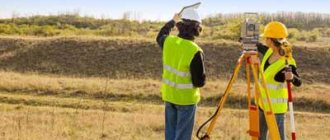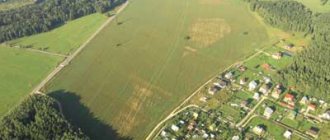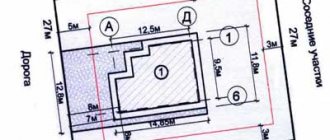Ownership of a land plot is one of the rights of a property owner. Its full implementation is possible only with a clear identification of a plot of land by establishing territorial boundaries.
A dispute over the boundaries of a land plot is a fairly common situation that arises between owners of adjacent plots. Often neighbors cannot agree on where the boundaries of their plots lie and who owns specific land. The procedure for resolving conflicts over the boundaries of adjacent plots of land has certain rules and features, which should be considered in more detail.
Regulatory regulation
In Russia, large-scale work has long been carried out to record the boundaries and land plots themselves. To achieve this, legislators introduced amendments to regulations:
- Land Code of the Russian Federation;
- Federal Law No. 218 dated July 13, 2015 “On state registration of real estate”;
- Federal Law of July 24, 2007 No. 221 “On the State Real Estate Cadastre.”
Increasingly, courts are faced with disputes regarding the boundaries of individual areas. Therefore, the obligation to prepare a boundary plan is introduced. In 2021, without it, it is impossible to register new plots of land or sell existing lands if land surveying has not been carried out previously.
Which lawyer or advocate should I choose?
The duty lawyer will help you choose a specialist. Call, briefly tell us your question, and they will advise you who is best to contact. Land lawyers and attorneys, even having such a narrow specialization, are also divided into sub-sectors, each having more in-depth knowledge of their field. There are trial lawyers or attorneys, there are “drafters” of land documents, there are conflict experts, registrars, assistants in the registration of inheritance cases, border disputes, etc. In the “About Us” section you can get acquainted with specialists and make an appointment by calling their offices.
Features of land surveying
To avoid a dispute about the boundaries of a land plot with neighbors, it is important to carry out land surveying in a timely and correct manner. These works make it possible to determine, secure and restore the area of the site within its boundaries. Other relevant information is also included in the documents.
Land surveying is carried out in the following cases:
- redistribution of lands in the process of their consolidation, division or creation of new objects;
- privatization of the site;
- clarification of boundaries;
- obtaining permission for construction work on building a house;
- obtaining a cadastral passport and other documentation for land;
- allocation of land from common property.
When an unauthorized building can be demolished
Earlier. An unauthorized building was demolished, almost always at the expense of the one who built it. That’s what it was written: subject to demolition. If you built it without documents or permits, demolish your house or legalize it.
From August 4th. Now they have written in more detail about the demolition of unauthorized buildings. By default, such a building cannot be used. This means that a kiosk built without permission cannot be used for trade.
But now the demolition is not so categorical. An unauthorized building may be demolished, or it may be brought into compliance with development requirements. But all this is at the expense of the one who built or uses the site. To demolish or bring into compliance is almost always decided by the court. Sometimes - local authorities.
Now there is a legal basis not to demolish the unauthorized building, but to bring it into compliance with the requirements of the law and the purpose of the site. For example, reduce the number of floors of a house or reconstruct a dacha so that part of it does not extend into another area or is not so close to a gas pipeline.
Border disputes
A frequent cause of conflicts between neighbors is disputes over the exact location of land boundaries. Some people do not want to give up part of their territory, but for others it becomes a matter of principle. The easiest way is to solve the problem peacefully before going to court. This makes it possible to avoid unnecessary costs and lengthy proceedings. Land disputes in Russia are considered one of the most complex. This is due to the fact that legislation in this area has not yet been fully developed. As a result, trials can last for several years.
To avoid unnecessary problems when operating the land, follow these simple recommendations:
- Check the documents provided by the cadastral engineer. Clarify unclear and controversial points in advance. At the stage of work, solving the problem is much easier and cheaper.
- If the boundaries have long been defined, it is better not to rely on old information and clarify the boundaries. To do this, you can request the boundaries to be taken out into nature, which will allow you to determine compliance with the actual location. During the process, it will be determined whether the boundaries of neighboring areas have overlapped.
Do not rush to contact the judicial and supervisory authorities for any reason. Questions may also arise regarding your land. First of all, it is important to make sure that your opinion is correct in relation to the passage of borders. And after that you can take further actions.
Customer Reviews
- "I am very grateful to such a wonderful specialist as Lyudmila Ivanovna Cherevkova. She understood everything instantly and was able to solve my complicated case that had been confusing for years! I am very grateful to her"
- Advekon is an excellent company. She privatized land in SNT for me in court for 18 thousand rubles. Very fast, professional and reasonable prices. Thank you".
- “Nadezhda Borisovna was in charge of my case. She came to us twice, and during these two times she managed to convince the neighbors that our border was where it should be according to the master gardening plan. Thanks to her for her work."
- “Dear Larisa Petrovna! Thank you for your professional work!”
You can find the full texts of reviews in the office at St. Petersburg, Grazhdansky Ave, 22: in the reviews book.
Causes of disputes
There are standard reasons for conflicts that often lead to litigation:
- Errors in documents from which information was entered into the unified real estate register. It is possible to overlap the boundaries of plots if cadastral work on some of them was carried out relatively recently, and on others more than 10 years ago.
- Incorrect calculations by the cadastral engineer when taking measurements. In this case, it is important to prove the groundlessness by ordering a repeat survey.
- Self-capture. In this case, the neighbors move the fence without permission. This leads to an illegal reduction in the territory of neighbors. It is important to try to come to an agreement with them. If they did this intentionally and do not make contact, a trial will help. If the court's decision is positive, the borders will be restored by bailiffs.
In 2021, it has become mandatory to coordinate land surveying results with neighbors. This is done during the work of a cadastral engineer. If the rights of neighbors in this matter have not been taken into account, they can protest the results of the procedure. This is possible even if the information is entered into the state register.
How to resolve a border dispute?
To avoid litigation, you should try to reach an agreement with your neighbors in advance. If the issue cannot be resolved peacefully, the following algorithm of actions is applied:
- If the register contains a technical error, you must submit an application to Rosreestr to correct it. Attach documents proving the error. The registration authority must make a decision within 3 days. The error will be corrected or denied based on the correctness of the information available.
- Clarify the boundaries of your site in relation to neighboring territories. This will be the best evidence for the court. In addition, some owners may be convinced before going to trial. Invite a cadastral engineer to survey and enter into an official contract with him for the work. During the procedure, boundaries are determined, after which an approval act is drawn up. It must be signed by all neighbors interested in resolving the dispute. It is important to notify everyone about the procedure at least 7 days before it begins.
If everyone received the notice, but one of the neighbors could not be present, he can familiarize himself with the act and sign it with the cadastral engineer. In case of failure to appear, the law allows approval of the document without it.
According to Art. 43 Federal Law No. 218, if one of the neighbors refuses to agree on boundaries, the issue can only be resolved through the court. To do this, a statement of claim is drawn up and supporting documents are attached. The defendant will be the owner of the adjacent plot, who interferes with the preparation of cadastral documents.
Carrying out work without the consent of neighbors
There are situations when a notice () was sent to the interested person and he received it, but did not react in any way. That is, he did not agree with him and did not formulate a reasoned refusal to answer.
Then the boundary can be considered consistent. In this case, it is necessary to record the fact that there was no refusal and attach documents that would confirm that the notice was sent to the neighbor.
Also, a written refusal, if any, should be attached to the approval act. This must be done to ensure that the approval procedure is followed, because if it is not followed, the land will not be registered in the Unified State Register of Real Estate.
After 30 days, you can call people for a second agreement.
How will the invader be punished?
Upon application, the land inspector goes to the scene of the alleged offense. He conducts an inspection and draws up a protocol. The violator is issued an order to eliminate the violation and pay a fine of 1,000 rubles.
Of course, administrative fines are small. But their presence will be the best confirmation of your rightness in court, if your neighbor does not stop violating your rights. It is important to keep records of violations. They must include the name of the offender.
Trial: documents
According to Art. 132 of the Code of Civil Procedure of the Russian Federation, the claim must be supported by copies of documents. The following are provided as applications:
- documents on ownership of the site;
- land survey plan;
- an extract from the Unified State Register of Real Estate about the adjacent plot of land, with the copyright holder of which a conflict has arisen;
- receipt of payment of state duty;
- other documents that can resolve the dispute in your favor.
If a boundary plan has not been drawn up at the time of application, an extended extract from Rosreestr can be provided instead. If this is not enough to make a decision, the judge may adjourn the hearing and oblige the parties to carry out surveying and determination of boundaries.
Location of the house on the site according to the standards
The rules for the location of a residential building on a site are regulated by several documents, namely:
- SP 42.13330.2016;
- SP 53.13330.2011;
- SP 30-102-99;
- PZZ of local government.
In accordance with these documents, the house must be located in accordance with the following requirements:
- at least 3 meters from the neighbors’ fence;
- at least 5 meters from the red line of the street;
- at least 3 meters from the red line of passages.
The roof of the building must be built in such a way as to completely prevent water from draining or snow falling onto the territory of neighbors.
When placing a building, it is also necessary to comply with existing fire safety distances.
Trial: procedure
The plaintiff can participate in court in person or enter into an agreement with a lawyer. It is important to seek the help of a qualified specialist whose practice is land and property disputes. If you win the case, the defendant will bear all your costs for the trial and the involvement of specialists.
According to Art. 30 of the Code of Civil Procedure of the Russian Federation, the claim must be filed in the territorial court. That is, in this case it is submitted to the court, which is located at the location of the site. In this case, the following consideration procedure is established:
- The Magistrate's Court considers disputes related to determining the procedure for using property, which includes land plots.
- The district court considers issues related to the establishment of boundaries.
If a positive decision is made, it will take effect within 30 days. During this time, the defendant can file an appeal to a higher authority, up to the Supreme Court of the Russian Federation.
In accordance with Articles 14 and 61 of Federal Law No. 218, the court decision is transferred to Rosreestr. It may require the correction of an error or the registration of property. To speed up the process, you can take a certified copy from the court with the writ of execution and submit them to Rosreestr yourself.
Fixing a registry error
If registration errors are made, which periodically occur when entering data on land plots, experts recommend sending requests to the territorial department of Rosreestr to correct the technical inaccuracy.
Employees of such a government body can correct the error on their own, but in practice most often they have to go to court , based on whose decision the necessary changes are made.
Limitation of actions
General rules apply to disputes. The statute of limitations is 3 years. It begins to be calculated from the moment the applicant becomes aware of violations against his rights.
It is often difficult to establish the exact date of reference when the violation was discovered. In this case, the court may reinstate the term. But to do this, you must submit a separate application or apply for an increase in time at the first meeting.
Thus, you can resolve a dispute about the boundaries of a land plot yourself or with the involvement of a court. In the first case, it will take a little time. But if one of the parties does not seek to resolve the conflict, you can resort to litigation.









